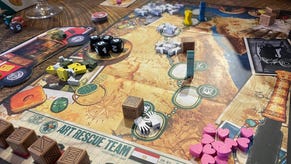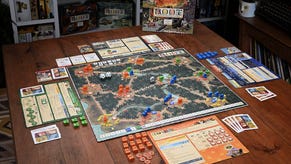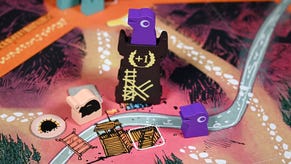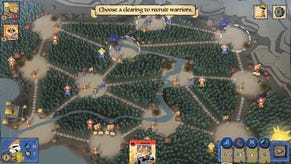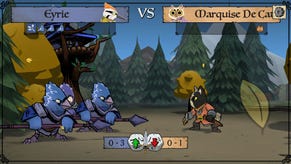Root’s show-don’t-tell storytelling makes its world feel alive
Eyrie-lly want to go back there.
A great battle is waging in the forest. Troops of birds and cats are cutting each other down, secret meetings are being held under the cover of night, and shady dealings are taking place on the edges of the treeline. This is the world of Root, an asymmetric board game set in a world of cute animals and luscious forests.
Though it might not appear so at first glance, the world of Root is a violent one. Three separate armies, plus a fourth renegade individual, are clashing with one another in one leaf-laden battlefield. While the game’s rulebook and deck of cards give a vague idea of what Root is about, it’s not until you start crossing swords with other players that you truly understand the destruction taking place here. I’m not just talking about the death animations featured in the digital version - though it’s hard not to feel sorry for those poor little critters falling in battle - but the vicious things you’ll end up doing to your fellow players.

Some big-box strategy board games, such as Scythe, will allow players enough wriggle room to sit in their own corners and work on their respective projects, Root doesn’t. The closest thing Root has to a pacifist option is the Vagabond - who has the option to form alliances with other factions to trade items and gain points - and even then it’s likely that they’ll find themselves getting caught up in one scrum or another.
I’ll try to avoid conflict wherever I can. But playing Root has made me into a monster.
Root forces its players to directly interact with one another, and usually that involves doing very mean things. In most board games, I’ll try to avoid conflict wherever I can. But playing Root has made me into a monster. I’ve ganged up on other players for my own benefit, messed up their plans and intentionally destroyed their property and murdered their soldiers. Even as the Vagabond. Root isn’t just violent because its factions are opposed to one another. It’s violent because it makes you do violent things.

Not to say that the factions in Root don’t have justifiable reasons to fight each other. Besides the tyrannical intentions of the Marquise de Cat - as described in the game’s rulebook - the entrepreneurial whiskery ones aren’t the only faction in the wrong here. The Eyrie are a bunch of foppish nobles dreaming of long-gone glory days, the Alliance are stirring up aggressive insurrection using impressionable civilians and the Vagabond is a ne'er-do-well who’s only in it for the profit. It really depends on whose perceptive you’re playing from.
Root does an incredible job of communicating each faction's essential personalities through gameplay.
Though there isn’t much explicit lore provided in the game’s text, I understand why each of these factions clash with one another thanks to the fact that Root does an incredible job of communicating their essential personalities through gameplay. You can tell that the Marquise de Cat treats her units like cannon fodder because they’re spread so thinly at the start of the game and seem to exist only to occupy enough space for her to build her machines. Whereas the Eyrie treat their soldiers like a full-blown army with larger numbers moving in groups to conquer clearings, and establish the dominance the faction needs to build roosts and win battles. These two opposed approaches to warfare communicate to the player that the Marquise de Cat is practical to the point of ruthlessness, and that the Eyrie are haughty enough that they require a show of force to get anything useful done.
Root communicates the opposing natures of the Woodland Alliance and Vagabond factions in a similar fashion as well. The Alliance are at their most formidable during the evening phase of the game, with the hard work of gathering support and allies done during the day - paying off when their units can burn enemy buildings and establish military camps in the darkness. The Vagabond, meanwhile, is unashamedly opportunistic, grabbing whatever they can from the ancient ruins hidden in the forest and breaking alliances at the drop of a hat - should it ever suit them to do so.
In our eyes, the Alliance has been a winning force in so many games that it has ceased being the underdog.
All of these story elements conveyed by the game’s mechanics are further enhanced by your own experiences of playing Root. Having gotten into a recent habit of playing Root on a weekly basis with the same people, we’ve created our own group narratives based on how we have played each faction. If you look at Root from an outsider’s perspective, the Alliance might appear to be the default ‘heroic’ faction. However, in our eyes, the Alliance has been a winning force in so many games that it has ceased being the underdog, instead becoming the faction that the rest of the players feel the need to keep constant tabs on. Conversely, the Eyrie continues to be the only faction that has failed to win a single game, due to repeated trips to the dreaded ‘birdy boiler’ - a semi-affectionate name we’ve given to Root’s turmoil mechanic.
Having the opportunity to play Root as often as I have with the same group of players has given me the chance to appreciate how good the game is at visual and mechanical storytelling. It’s a board game that communicates its world-building almost entirely through gameplay, forcing the player to interact with it to understand the story behind it - which conveniently enough also leads to players creating their own stories as well. All of this really establishes Root as being a game about folklore - wherever that’s the tales told by the different peoples of the wood or the players who direct them.



